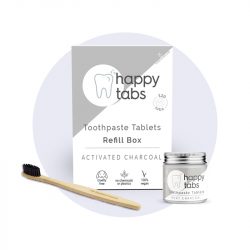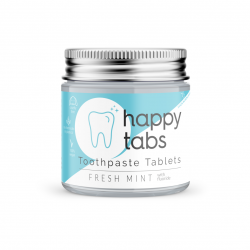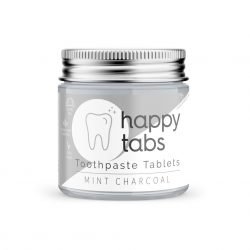Did you know that around 1.5 billion toothpaste tubes are discarded worldwide every year?
That says this 2019 report from Recycling International.
Yes, the good old tube of toothpaste is made up of aluminum and plastic, is very difficult to recycle and so ends up in landfills and oceans.
The solution to this? Enter: toothpaste tablets.
Basically, chewable bites that you chew into a paste and brush with, and that give you the same oral health benefits than traditional toothpaste, without wreaking havoc on the planet.
They reduce plastic waste since they come in reusable jars or recyclable packaging.
And they spare you the annoying task of rolling the tube!
Plus, they’re easy to pack and are natural and vegan. And super fresh!
The difference between toothpaste tablets and regular toothpaste
Besides the packaging and travel-friendly features, there are differences in the ingredients of each.
Regular toothpastes contain water to create the creamy texture and often some type of preservatives, such as parabens or sodium benzoate, because liquids can be a breeding ground for bacteria and mold.
Since toothpaste tablets are formulated without using water, they can be made with few or even no preservatives.
Nonetheless this doesn’t mean they’re not effective: many of the natural ingredients they contain (such as coconut oil and sugar alcohols, such as xylitol and sorbitol) have antibacterial properties.
And the formulas we offer you here at Bluehouse are also free of sodium lauryl sulfate (SLS), which is a common irritant that can increase tooth sensitivity and cause canker sores.
(You’ll see “Sodium Lauryl Sulfoacetate” in the ingredient list of the Happy Tabs brand. Don’t panic! That’s not SLS, it’s just a natural derived foamer from coconut).
And a nice eco-friendly plus: for each Beewise tablets you buy, a tree is planted!
What about fluoride?
Fluoride is a natural mineral that’s commonly found in the earth’s crust and in many foods and water sources.
Many specialists state that fluoride helps prevent tooth decay by making the tooth more resistant to acid attacks from plaque bacteria and sugars in the mouth, and it also reverses early decay.
There certainly is a toxic level of fluoride. But according to Dr. Jan Mitchell, a dentist at the Dental College of Georgia, in both fluoridated water and toothpastes the levels are very low and safe.
However, many people choose to go fluoride-free because they doubt its benefits or because they are allergic to it.
Here at Bluehouse we offer you both fluoride and fluoride-free options, so you can choose the one that better suits your needs and beliefs.

How to use toothpaste tablets
There’s a learning curve to liking toothpaste tablets since they need to be chewed before becoming a brushable paste. That may feel weird at the beginning, but it’s just a matter of getting used to the habit.
So how does it work?
- Crush the toothpaste tablets between your teeth. Chew until it turns into a soft minty paste.
- Brush with a wet toothbrush. The toothpaste tablet will start to foam up, just like you are used to.
- Tablets are very delicate and susceptible to moisture. So it’s better to store them in jars and to shut the lids at all times.
We recommend you complement this sustainable oral care routine with other healthy oral habits: brush at least twice a day; take your time to brush properly, moving the toothbrush in gentle, circular motions to remove plaque; floss; drink plenty of water to maintain the pH balance of your saliva; and limit sugary and acidic foods that can lead to cavities and wear down your tooth enamel.




